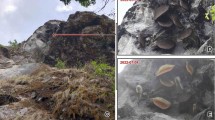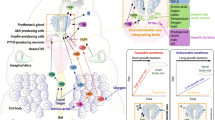Abstract
We here show an example of morphological novelties, which have evolved from insect wings into the specific structures controlling social behaviour in an ant species. Most ant colonies consist of winged queen(s) and wingless workers. In the queenless ponerine ant Diacamma sp. from Japan, however, all female workers have a pair of small thoracic appendages, called “gemmae”, which are homologous to the forewings and acts as an organ regulating altruism expression. Most workers, whose gemmae are clipped off by other colony members, become nonreproductive helpers, while only a single individual with complete gemmae becomes functionally reproductive. We examined histologically the development of gemmae, and compared it with that of functional wings in males. Female larvae had well-developed wing discs for both fore- and hindwings. At pupation, however, the wing discs started to evaginate and later degenerate. The hindwing discs completely degenerated, while the degeneration of forewing discs was incomplete, leading to the formation of gemmae. The degeneration process involved apoptotic cell death as confirmed by TUNEL assay. In addition, glandular cells differentiated from the epithelial cells of the forewing buds after completion of pupation. The mechanism of developmental transition from wing to gemma can be regarded as an evolutionary gain of new function, which can be seen in insect appendages and vertebrate limbs.






Similar content being viewed by others
References
Abouheif E, Wray GA (2002) Evolution of the gene network underlying wing polyphenism in ants. Science 297:249–252
Baudry E, Peeters C, Brazier L, Veuille M, Doums C (2003) Shift in the behaviours regulating monogyny is associated with high genetic differentiation in the queenless ant Diacamma ceylonense. Insect Soc 50:390–397
Billen J, Peeters C (1991) Fine structure of the gemma gland in the ant Diacamma australe Hymenoptera Formicidae. Belg J Zool 121:203–210
Buschinger A (1987) Polymorphism and reproductive division of labor in advanced ants. In: Eder J, Rembold H (eds) Chemistry and biology of social insects. Peperny, Munich, pp 257–258
Carroll SB, Grenier JK, Weatherbee SD (2001) From DNA to diversity. Molecular genetics and the evolution of animal design. Blackwell Science, Massachusetts
Chapman RF (1998) The insects, structure and function, 4th edn. Cambridge University Press, Cambridge
Cotter TG, Lennon SV, Glynn JM, Green DR (1992) Microfilament-disrupting agents prevent the formation of apoptotic bodies in tumor cells undergoing apoptosis. Cancer Res 52:997–1005
Cuvillier-Hot V, Gadagkar R, Peeters C, Cobb M (2002) Regulation of reproduction in a queenless ant: aggression, pheromones and reduction in conflict. Proc R Soc Lond B 269:1295–1300
Dewitz H (1878) Beitrage zur postembryonalen gliedmassenbildung bei den insecten. Z Wiss Zool 30:78–105
Dohrmann CE, Nijhout HF (1988) Development of the wing margin in Precis coenia (Lepidoptera: Nymphalidae). J Res Lepidoptera 27:151–159
Estabel J, Mercer A, König N, Exbrayat J-M (2003) Programmed cell death in Xenopus laevis spinal cord, tail and other tissues, prior to, and during, matamorphosis. Life Sci 73:3297–3306
Fujiwara H, Ogai S (2001) Ecdysteroid-induced programmed cell death and cell proliferation during pupal wing development of the silkworm, Bombyx mori. Dev Genes Evol 211:118–123
Fukumoto Y, Abe T, Taki A (1989) A novel form of colony organization in the “queenless” ant Diacamma rugosum. Physiol Ecol Jpn 26:55–61
Gavrieli Y, Sherman Y, Ben-Sasson SA (1992) Identification of programmed cell-death in situ via specific labeling of nuclear-DNA fragmentation. J Cell Biol 119:493–501
Gronenberg W, Peeters C (1993) Central projections of the sensory hairs on the gemma of the ant Diacamma: substrate for behavioral modulation? Cell Tissue Res 273:401–415
Hölldobler B, Wilson EO (1990) The ants. Belknap, Harvard
Kerr JF, Wyllie AH, Currie AR (1972) Apoptosis: a basic biological phenomenon with wide-ranging implications in tissue kinetics. Br J Cancer 26:239–257
Kloft WJ, Alfred B, Karola H (1994) Larvale anlage von Flugelimaginalscheiben bei normal- und pygmaen- arbeiterinnen der wegameise Lasius niger (Hymenoptera: Formicidae). Entomol Gen 19:9–13
Kodama R, Yoshida A, Mitsui T (1995) Programmed cell death at the periphery of the pupal wing of the butterfly, Pieris rapae. Roux’s Arch Dev Biol 204:418–426
Lobia S, Niitsu S, Fujiwara H (2003) Female-specific wing degeneration caused by ecdysteroid in the Tussock moth, Orgyia recens: hormonal and developmental regulation of sexual dimorphism. J Insect Sci 3:11–17
Lockshin RA, Zakeri Z (2001) Programmed cell death and apoptosis: origins of the theory. Nat Rev Mol Cell Biol 2:545–550
Meier P, Finch A, Evan G (2000) Apoptosis in development. Nature 407:796–801
Monnin T, Peeters C (1999) Dominance hierarchy and reproductive conflicts among subordinates in a monogynous queenless ant. Behav Ecol 10:323–332
Nakajima K, Yaoita Y (2003) Dual mechanisms governing muscle cell death in tadpole tail during amphibian metamorphosis. Dev Dyn 227:246–255
Nakata K, Tsuji K (1996) The effect of colony size on conflict over male-production between gamergate and dominant workers in the ponerine ant Diacamma sp. Ethol Ecol Evol 8:147–156
Nakata K, Tsuji K, Hoelldobler B, Taki A (1998) Sexual calling by workers using the metatibial glands in the ant, Diacamma sp., from Japan (Hymenoptera: Formicidae). J Insect Behav 11:869–877
Nardi JB, Magee-Adams SM (1986) Formation of scale spacing patterns in a moth wing. 1. Epithelial feet may mediate cell rearrangement. Dev Biol 116:278–290
Noirot C, Quennedy A (1974) Fine structure of insect epidermal glands. Ann Rev Entomol 19:61–81
Peeters C, Billen JPJ (1991) A novel exocrine gland inside the thoracic appendages (‘gemmae’) of the queenless ant Diacamma australe. Experimentia 47:229–231
Peeters C, Crewe R (1984) Insemination controls the reproductive division of labour in a ponerine ant. Naturwissenschaften 71:50–51
Peeters C, Crozier R (1988) Caste and reproduction in ants: not all mated egg-layers are “queen”. Psyche 95:283–288
Peeters C, Higashi S (1989) Reproductive dominance controlled by mutilation in the queenless ant Diacamma australe. Naturwissenschaften 76:177–180
Peeters C, Billen JPJ, Hölldobler B (1992) Alternative dominance mechanisms regulating monogyny in the queenless ant genus Diacamma. Naturwissenschaften 79:572–573
Sameshima S, Miura T, Matumoto T (2004) Wing disc development during caste differentiation in the ant Pheidole megacephala (Hymenoptera: Formicidae). Evol Dev 6:336–341
Sommer K, Hölldobler B, Rembold H (1993) Behavioral and physiological aspects of reproductive control in a Diacamma species from Malaysia (Formicidae, Ponerinae). Ethology 94:162–170
Tittel JN, Steller H (2000) A comparison of programmed cell death between species. Genome Biol 1: 3.1–3.6
Tsuji K, Peeters C, Hölldobler B (1998) Experimental investigation of the mechanism of reproductive differentiation in the queenless ant, Diacamma sp., from Japan. Ethology 104:633–643
Tulloch GS (1934) Vestigial wings in Diacamma (Hymenoptera: Formicidae). Ann Entomol Soc Am 27:273–277
Wheeler WM (1905) Worker ants with vestigial wings. Bull Am Mus Nat Hist 21:405–408
Wilson EO (1971) The insect societies. Belknap, Harvard
Wyllie AH, Kerr JFR, Currie AR (1980) Cell death: the significance of apoptosis. Int Rev Cytol 68:251–306
Zuzarte-Luis V, Hurle JM (2002) Programmed cell death in the developing limb. Int J Dev Biol 46:871–876
Acknowledgements
We thank S. Kawabata for introducing us to the sampling site of the focal ant species and for help in field sampling. Thanks are also due to R. Cornette, M. Machida, H. Katoh and S. Koshikawa for their assistance in field investigations, to C. Peeters for constructive comments on the manuscript, and to F. G. Issa for English editing. This work was supported by a Grant-in-Aid for Scientific Research (nos. 15687001, 13740435 and 13440228) from the Ministry of Education, Culture, Sports, Science and Technology of Japan, and by a Grant-in-Aid from the Research for the Future Program of the Japan Society for the Promotion of Sciences (JSPS).
Author information
Authors and Affiliations
Corresponding author
Additional information
Edited by P. Simpson
Rights and permissions
About this article
Cite this article
Gotoh, A., Sameshima, S., Tsuji, K. et al. Apoptotic wing degeneration and formation of an altruism-regulating glandular appendage (gemma) in the ponerine ant Diacamma sp. from Japan (Hymenoptera, Formicidae, Ponerinae). Dev Genes Evol 215, 69–77 (2005). https://doi.org/10.1007/s00427-004-0456-7
Received:
Accepted:
Published:
Issue Date:
DOI: https://doi.org/10.1007/s00427-004-0456-7




